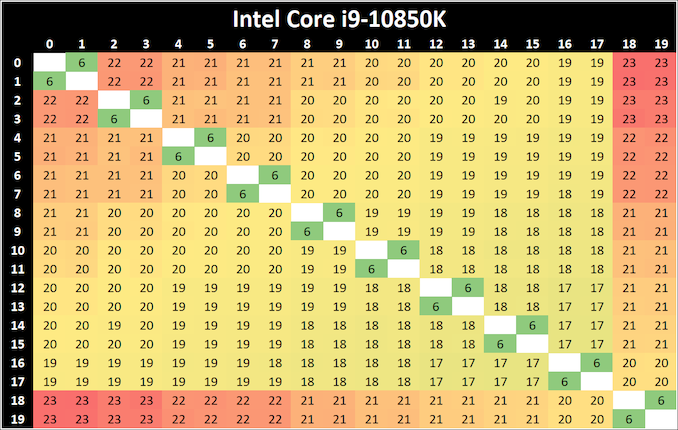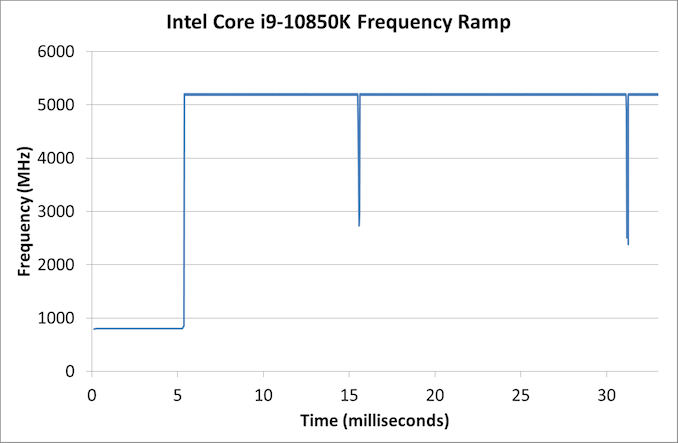Intel Core i9-10850K Review: The Real Intel Flagship
by Dr. Ian Cutress on January 4, 2021 9:00 AM EST- Posted in
- CPUs
- Intel
- Core
- Z490
- 10th Gen Core
- Comet Lake
- LGA1200
- i9-10850K
CPU Tests: Microbenchmarks
Core-to-Core Latency
As the core count of modern CPUs is growing, we are reaching a time when the time to access each core from a different core is no longer a constant. Even before the advent of heterogeneous SoC designs, processors built on large rings or meshes can have different latencies to access the nearest core compared to the furthest core. This rings true especially in multi-socket server environments.
But modern CPUs, even desktop and consumer CPUs, can have variable access latency to get to another core. For example, in the first generation Threadripper CPUs, we had four chips on the package, each with 8 threads, and each with a different core-to-core latency depending on if it was on-die or off-die. This gets more complex with products like Lakefield, which has two different communication buses depending on which core is talking to which.
If you are a regular reader of AnandTech’s CPU reviews, you will recognize our Core-to-Core latency test. It’s a great way to show exactly how groups of cores are laid out on the silicon. This is a custom in-house test built by Andrei, and we know there are competing tests out there, but we feel ours is the most accurate to how quick an access between two cores can happen.
When we first reviewed the 10-core Comet Lake processors, we noticed that a core (or two) seemed to take slightly longer to ping/pong than the others. We see the same pattern here again with the final core.
Frequency Ramping
Both AMD and Intel over the past few years have introduced features to their processors that speed up the time from when a CPU moves from idle into a high powered state. The effect of this means that users can get peak performance quicker, but the biggest knock-on effect for this is with battery life in mobile devices, especially if a system can turbo up quick and turbo down quick, ensuring that it stays in the lowest and most efficient power state for as long as possible.
Intel’s technology is called SpeedShift, although SpeedShift was not enabled until Skylake.
One of the issues though with this technology is that sometimes the adjustments in frequency can be so fast, software cannot detect them. If the frequency is changing on the order of microseconds, but your software is only probing frequency in milliseconds (or seconds), then quick changes will be missed. Not only that, as an observer probing the frequency, you could be affecting the actual turbo performance. When the CPU is changing frequency, it essentially has to pause all compute while it aligns the frequency rate of the whole core.
We wrote an extensive review analysis piece on this, called ‘Reaching for Turbo: Aligning Perception with AMD’s Frequency Metrics’, due to an issue where users were not observing the peak turbo speeds for AMD’s processors.
We got around the issue by making the frequency probing the workload causing the turbo. The software is able to detect frequency adjustments on a microsecond scale, so we can see how well a system can get to those boost frequencies. Our Frequency Ramp tool has already been in use in a number of reviews.
The Core i9-10850K ramps up extremely quickly from idle to peak turbo, in the region of about 5 milliseconds. This is faster than the 16 ms we typically observe.












126 Comments
View All Comments
Oxford Guy - Thursday, January 7, 2021 - link
Anarfox? Your reply was in response to my post.Dug - Monday, January 4, 2021 - link
It's just like saying very few users download video card drivers and just use what's built into Windows. So that's how were going to test. Really?No. Very few users will buy a 10850-K because it's an enthusiasts chip meant to be overclocked. So if you are reviewing an enthusiasts chip, maybe you should benchmark it like someone that knows what they bought.
Oxford Guy - Thursday, January 7, 2021 - link
"It's just like saying very few users download video card drivers and just use what's built into Windows. So that's how were going to test. Really?"Good point.
eastcoast_pete - Monday, January 4, 2021 - link
About that line on IBM's z-Series processors: I thought about that, but decided against getting one of those. The design of the z-series clashes with the design of my furniture, and the price with the size of my bank account (:boozed - Monday, January 4, 2021 - link
So, what you're saying is that I should buy a Ryzen 5000?lucasdclopes - Monday, January 4, 2021 - link
Is the TRUE Copper still a good cooler? How does it compares to today offerings? I mean, yeah, it is 2Kg of copper, bug there is also more than 10 years of evolution in cooler design.I'm asking because, holy shit, those temperatures are terrible.
Oxford Guy - Thursday, January 7, 2021 - link
"there is also more than 10 years of evolution in cooler design"Can't overcome the laws of physics.
lucasdclopes - Monday, January 4, 2021 - link
"With the Ryzen 7 5800X, there’s no worrying about excessive power or thermals, which in of itself is perhaps peace of mind.On performance against AMD, the 5800X wins on single threaded loads by 15-20% and encoding, while the 10850K wins on rendering multithreaded workloads like Blender by up to 10%. "
Oh my god it is amazing how the tables have turned so fast.
Intel is the hotter, power hungrier, with slower but more cores at the same price point now.
Oxford Guy - Thursday, January 7, 2021 - link
Unless the power consumption is equivalent it's not a win.29a - Monday, January 4, 2021 - link
"So why test it at all? Firstly, because we need an AI benchmark, and a bad one is still better than not having one at all."I can't disagree with this statement enough, bad data is worse than no data.